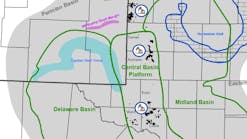TECHNOLOGY Backward orifice plate causes major gas flow measurement error
John R. Bower
Natural Gas Associates of Colorado
Denver
Reverse installation of an orifice plate in a natural-gas orifice meter can cause a reading for calculated flow that is 15-17% less than actual.
A revision of typical calibration report forms can make this less likely to happen.
The hole through an orifice plate is precisely machined round with a sharp edge on the upstream side and a beveled edge downstream (Fig. 1)(64492 bytes).
Backwards installation of the orifice plate, that is with the beveled edge upstream, will invalidate the governing calculations described in AGA's Report No. 3, "Orifice Metering of Natural Gas."
Flow calculations
AGA's calculation of the volume flowing through the orifice plate assumes flow into the square edge. When the flow is through the beveled edge, the meter simply records a lower differential pressure and results in a lower calculated volume.
Gas flow (Q) through an orifice plate equals a constant (C') multiplied by the square root of the pressure drop across the orifice in inches of water (hw) and by the square root of the flowing absolute pressure (Pf):
Q = C' hwwwPwfw
The constant combines a series of factors based on the size of the meter run, the orifice diameter, gas composition, and the pressure and temperature of the gas flowing through the meter. The constant assumes that all conditions and factors are consistent with specifications laid out in Report No. 3.
While describing the correct flow direction, AGA No. 3 does not describe the magnitude of the error caused by incorrect installation.
Installation
In a simple flange orifice meter run, the orifice plate fits between two flanges (Fig. 2)(33176 bytes). The orifice plate has a handle that extends beyond the flanges and exhibits a stamping for the orifice size, material of construction, and inlet side. Verifying size and flow direction is easy even if the plate is mislabeled by physically removing it to verify the stampings and ensure the flow tube is clean and the orifice undamaged.
In a single or dual chamber orifice fitting, backward installation is surprisingly easy because the plate is merely a round disc (Fig. 1) with the orifice machined in the center, that is, there is no handle.
The orifice plate is placed in a rubber donut or disc, and the donut and orifice plate assembly is inserted into the orifice fitting. The donut is a seal to prevent gas flowing around the perimeter of the orifice plate instead of through the hole. With no mechanical fitting to prevent backwards installation, removing the plate is the only means for checking flow direction.
Quantifying the error
Most gas meter-calibration errors are in the range of 2% or less. The error from a backwards orifice plate, however, results because it takes less energy (pressure drop) to push a fixed quantity of gas through a hole with a beveled edge than through a hole with a square edge.
It does not matter whether the volume is calculated from a gas chart or by an electronic meter; the error is the same.
Once the orifice is installed, correct orientation can only be confirmed by removing the plate, as stated. When the plate is removed, it is easy to miss whether the orientation was correct, unless the meter technician is alert to that possible source of error.
The problem came to light recently at a field delivery point where the seller had an orifice-meter run with a strip-chart recorder, and the transporter had a separate orifice-meter run with an electronic gas meter. Both meter runs and orifice sizes were the same. The seller noticed that after many months of agreement between the two meters, the electronic meter (pay meter) started recording less gas than the strip-chart meter (check meter).
A plot was made of the daily volume of gas as recorded by the strip-chart check meter and the electronic gas meter. The plot (Fig. 3)(22170 bytes) shows the two meters recording essentially the same volumes through the ninth day of the month. This pattern was consistent for many months before this date.
On the ninth day, the field was shut in for pipeline maintenance, and the electronic meter was calibrated. On the tenth day, the electronic gas meter recorded significantly greater flow than the strip chart.
A review of the strip chart showed that the meter went off scale several times that day. Apparently, the electronic meter did a better job of recording the high flow periods.
Starting with the eleventh day, however, the electronic meter recorded consistently less flow than the strip chart.
The electronic gas meter continued to record a lower volume until the meter was again calibrated 3 months later (on the 24th day; Fig. 4)21042 bytes).
That figure shows that the two meters once again recorded similar volumes. No errors appeared in calibration or data, and both meters were operating properly.
Neither meter-calibration report, however, mentioned that the orifice plate in the electronic meter had been installed backwards, although both calibrations were witnessed. Neither calibration report had a box to check for correct flow direction.
Both buyer and transporter agreed that the orifice plate was installed backwards during this time. The metered volume worked out to be 15 to 16% less than the actual volume for the 3-month period. The transport pipeline agreed to correct the volume loss.
This volume loss compares closely with the 12 to 17% error reported by Chevron Oil Field Research Co.1
Chevron ran a series of tests using 4-in. and 6-in. meter runs and orifice sizes varying from 0.6 to 4.5 in. The tests used low pressure air flowing at 9 psig.
In the example presented here, gas was flowing through a 1.25-in. orifice in a 4-in. meter run. The 1,100 BTU/cu ft gas was flowing at 700-800 psig and 35-70 F.
Although the flowing conditions differed from the Chevron tests, the results were the same.
What to do
Most companies have elaborate procedures to record orifice plate changes and meter calibration or operation problems. But the orifice flow direction is not emphasized as strongly as it should be.
The author has reviewed many gas-meter calibration reports and found none with a box that could be checked to show that the orifice flow direction was verified and correct. Clearly, meter-calibration reports should be changed to include such a box.
This simple problem is easy to miss. In the example cited, the magnitude of the error would not have been quantified without a completely separate check meter and meter run. Without a separate meter run, the check meter would have read the same "low" volume because it would have been recording the differential across the same backward orifice plate.
There is no substitute for a completely separate check meter and meter run.
Reference
1. Ting, V.C., "Effects of Nonstandard Operating Conditions on the Accuracy of Orifice Meters." SPE No. 22867, presented at the 68th Annual Technical Conference and Exhibition of the Society of Petroleum Engineers, Dallas, Oct. 6-9, 1991.
The Author
John Bower is a partner in the consulting firm of Natural Gas Associates of Colorado in Denver. Before joining Natural Gas Associates, he worked for Shell Oil Co., New Orleans, in gas processing and project management. Bower is a registered professional engineer in four states and holds a chemical engineering degree from the University of Michigan. He is a member of the National Society of Professional Engineers and the Independent Petroleum Association of the Mountain States.
Copyright 1995 Oil & Gas Journal. All Rights Reserved.

